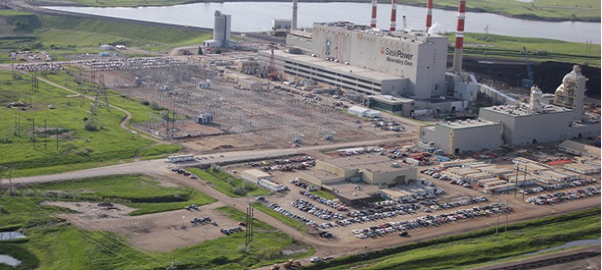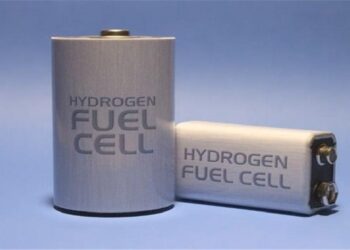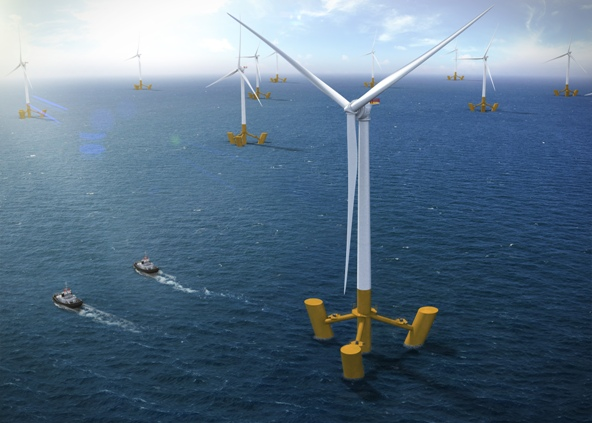The first full-scale commercial post-combustion carbon capture and sequestration (CCS) project at an operating coal-fired power plant is now online in Estevan, Saskatchewan, roughly 10 miles north of the U.S. border. The heart of the $1.4 billion project at Boundary Dam Power Station is the rebuilt 110-MW Unit 3, originally commissioned in 1970.
The project, which celebrated its grand opening Oct. 2, has given a new mission to an aging power plant, the largest coal-fired plant in the SaskPower fleet. The six Boundary Dam Power Station units were originally commissioned between 1959 and 1978 and have a combined capacity of 824 MW. The utility, a Crown corporation, derives about half of its generation from three coal-fired power stations; seven hydroelectric plants, six natural gas plants, and two wind facilities make up the balance of the total 3,513 MW owned by the company.
When fully optimized, the Boundary Dam project will capture 90% of Unit 3’s carbon dioxide (CO2), using an amine-based process, reducing emissions from 1.1 million metric tons to 100,000 metric tons per year (Figure 1). (Mississippi Power’s $5.6 billion integrated gasification combined cycle 582-MW Kemper County Energy Facility, using pre-combustion carbon capture, is expected to capture 65% of CO2 emissions at completion, which is expected the end of this year. The Petra Nova Carbon Capture Project, which began construction this summer, expects to capture 90% of the CO2 in the processed flue gas from the existing WA Parish power plant in Texas, using the post-combustion amine capture process pilot tested at Alabama Power’s Plant Barry.)
in October 2014, SaskPower’s Boundary Dam Unit 3 in Estevan, Saskatchewan, became the first coal-fired power plant to employ full-scale post-combustion carbon capture and sequestration. Courtesy: SaskPower
SaskPower operates its own Amine Chemical Laboratory, which analyzes environmental contaminants that may be produced as a result of carbon capture. Concerns about possible amine-based health risks stalled work on Norway’s Mongstad refinery CCS project in late 2010.
After the amine is sprayed in flue gases to capture CO2 molecules and 100% of sulfur dioxide (SO2), the solution is heated to release the greenhouse gas (GHG), which is compressed. The majority is piped 40 miles for use in enhanced oil recovery (EOR); the balance is stored 1.2 miles west of the power plant and 2.1 miles underground in a layer of brine-filled sandstone.
The injection site for what is expected to be permanent underground storage is at the company’s Carbon Storage and Research Centre (CSRC), which includes The Aquistore Project, an independent research and monitoring project administered by the Petroleum Technology Research Centre, which is responsible for measurement, monitoring, and verification of the underground storage activities throughout the project’s life.
The project received US$220 million from the Canadian federal government. SaskPower financed the remainder. The Boundary Dam project is a research and knowledge-sharing consortium effort whose members include TNO (the Netherlands), TCM Mongstad (Norway), and the National Carbon Capture Center (U.S.).
The energy penalty for post-combustion CCS, for both the capture and compression processes, is usually estimated at 20%, which is the figure anticipated by SaskPower for Boundary Dam. Nevertheless, company spokespersons have insisted throughout the project’s six-year development that the technology can deliver an economic outcome. The expectation is that lessons learned by SaskPower and the project’s consortium members will help lower the cost of subsequent projects around the world.
In addition to revenues from the sale of compressed gas used in EOR, SaskPower says there will be opportunities for the sale of other project byproducts, including captured SO2, which will be converted to sulfuric acid and sold for industrial use, and fly ash, which will be sold for use in ready-mix concrete, pre-cast structures, and concrete products. SaskPower plans to evaluate the project for two years before deciding if it will expand the CCS process to other units at the plant.
As in the U.S., SaskPower’s CCS activities are being driven by federal regulation. In 2012, Canada’s federal government finalized rules requiring new coal-fired power plants that begin construction after July 1, 2015, to be equipped with CCS technology that brings GHG emissions down to a level equivalent to those from high-efficiency gas plants. Plants built before 1975 would have to close by 2020, and those built after 1975 would have to close by 2030—unless equipped with CCS.
SaskPower also has a joint venture with Mitsubishi Hitachi Power Systems that is building a Carbon Capture Test Facility (CCTF) at the Shand Power Station near Estevan, which is expected to be complete next year. Though several pilot projects worldwide are testing carbon capture, the CCTF will be the only test facility adjacent to a full-scale CCS project. SaskPower says it will offer the facility and technical support to companies testing post-combustion capture technologies. Initial research at the CCTF will focus on energy demand, collection efficiency, long-term stability, operation, maintenance, and reliability of amine-based post-combustion capture technologies, but the facility has been designed to accommodate other processes as well.
Estevan is known as the province’s Energy Capital for its oil, natural gas, and coal resources. Project developers say Saskatchewan has 300 years of coal reserves. By investing in CCS technology development and research, the province hopes to be able to supply affordable power long into the future while advancing cleaner coal technology adoption around the world.






































